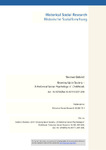Growing Up in Society - A Historical Social Psychology of Childhood
| dc.contributor.author | Gabriel, NR | en |
| dc.date.accessioned | 2017-12-19T22:46:59Z | |
| dc.date.available | 2017-12-19T22:46:59Z | |
| dc.date.issued | 2017-12-20 | en |
| dc.identifier.issn | 0172-6404 | en |
| dc.identifier.uri | http://hdl.handle.net/10026.1/10446 | |
| dc.description.abstract |
Abstract: This paper develops a historical social psychology that can be used to understand young children’s social development. It compares the theoretical frameworks of three of the most important relational thinkers in the 20th century – Norbert Elias, Pierre Bourdieu, and Erich Fromm – to shed light on their attempts to integrate the insights of psychoanalysis into their sociological perspectives. I begin by exploring Bourdieu’s “uneasy” relationship with psychoanalysis, arguing that this has led to a less than successful quest by his followers for bridging concepts that can further develop the concept of social habitus. Fromm, one of the foremost but relatively neglected psychoanalysts of his generation, developed a relational psychoanalysis to explain the social relatedness of individuals in society. However, although his key concept of social character is a bold attempt to make sense of the historical forces that shape our individual and collective lives, it is still too heavily tied to the influence of economic structures in society. I argue that Elias is a more consistent, relational sociologist, able to develop highly nuanced concepts that can fully explain the social habitus of young children, focusing on his concept of “love and learning relationships” to explain how they grow up in society. | en |
| dc.format.extent | 207 - 226 (20) | en |
| dc.language.iso | en | en |
| dc.publisher | GESIS - Leibniz Institute for the Social Sciences | en |
| dc.subject | Elias, Bourdieu, habitus, social character, social psychology, relational sociology, childhood. | en |
| dc.title | Growing Up in Society - A Historical Social Psychology of Childhood | en |
| dc.type | Journal Article | |
| plymouth.issue | 4 | en |
| plymouth.volume | 42 | en |
| plymouth.publisher-url | http://0172-6404/ | en |
| plymouth.journal | Historical Social Research | en |
| dc.identifier.doi | 10.12759/hsr.42.2017.4.207-226 | en |
| plymouth.organisational-group | /Plymouth | |
| plymouth.organisational-group | /Plymouth/Faculty of Arts, Humanities and Business | |
| plymouth.organisational-group | /Plymouth/Faculty of Arts, Humanities and Business/Plymouth Institute of Education | |
| plymouth.organisational-group | /Plymouth/REF 2021 Researchers by UoA | |
| plymouth.organisational-group | /Plymouth/REF 2021 Researchers by UoA/UoA23 Education | |
| plymouth.organisational-group | /Plymouth/Research Groups | |
| plymouth.organisational-group | /Plymouth/Research Groups/Institute of Health and Community | |
| dcterms.dateAccepted | 2017-11-21 | en |
| dc.rights.embargoperiod | Not known | en |
| rioxxterms.versionofrecord | 10.12759/hsr.42.2017.4.207-226 | en |
| rioxxterms.licenseref.uri | http://www.rioxx.net/licenses/all-rights-reserved | en |
| rioxxterms.licenseref.startdate | 2017-12-20 | en |
| rioxxterms.type | Journal Article/Review | en |


